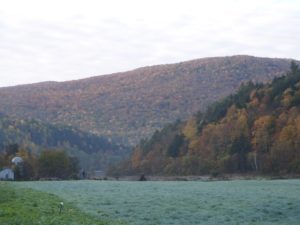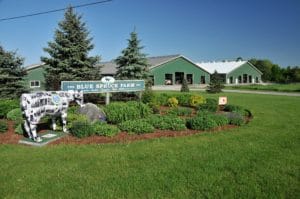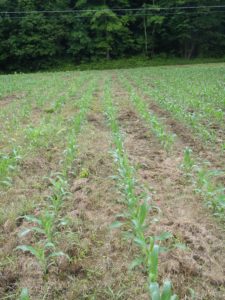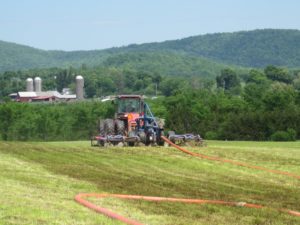Hot Topic: Improving Water Quality on Dairy Farms in Vermont
by Rachel Carter
Vermont in summer; blue skies, mountain breezes, and dairy cows dappling the working landscape—a source of both heritage and economic growth for Vermonters. The hottest of Vermont summer days are the perfect excuse to skip out of life’s everyday responsibilities and dunk in a stream, dip in a pond, or dive in a lake. In northwestern Vermont, the shores of the nation’s sixth largest lake, Lake Champlain, resemble more of a seaside escape than a lake. Until one encounters a blue-green algae bloom.
The blooms are the result of cyanobacteria bacteria that can form into large visible colonies due to interactions with excessive nutrient loads in the lake. The blooms release toxins, which can pose serious harm to humans and animals through oral or skin exposure. In recent years, these blooms have been on the rise on the warmest days, with more beaches closing on a consistent basis, especially in the Missisquoi Bay—an area downslope of the highest concentration of Vermont’s dairy farms.
Dairy farms have been at the center of the water quality discussion because they make up the largest portion of agricultural land use in Vermont. Certain types of production practices at conventional dairy farms have detrimental effects on Vermont lakes, rivers, and streams. Lake Champlain and phosphorus are the focal point because of the magnitude and importance of the lake, and because of the high number of dairy farms in Northwest Vermont.
But phosphorus loading is not the only area of concern when discussing issues around water quality, the environment, and agriculture. Data obtained from the Vermont Agency of Agriculture, Food & Markets reveals that pesticides used on corn—the primary feed source for conventional dairy farms—make up the majority of pesticides used in Vermont. Of the pesticides used, some have negative health impacts on both the environment and humans. Pesticide use on corn has been on the increase in the past seven years, as dairy farms have gotten larger. Additionally, according to data from the EPA and Census of Agriculture, synthetic nitrogen fertilizer has been on the increase in the last decade and the amount of synthetic fertilizer has actually been applied to less land, meaning more is being applied per acre. Excess nitrogen loading is an emerging concern in the Connecticut River watershed.

Corn silage field at Lucas Dairy LLC in Starksboro, Vermont planted with a winter rye cover crop after corn harvest. Photo by UVM Extension
It’s not all bad news, however, and movement is underway in the state and on farms to create a stronger culture of stewardship. Vermont’s governor, legislature, and state agencies are committed to advancing Vermont’s food system and increasing coordination and communication among farm and food sector organizations, which are explicit goals of Vermont’s Farm to Plate Strategic Plan, a statewide plan to strengthen the food system. The collaboration taking place in Vermont trickles down to all areas impacting the food system, including water quality. With the help of multiple funding sources, including $45 million from USDA, heightened technical assistance and stewardship practices will be expanded upon in Vermont—particularly in the areas surrounding and feeding into Lake Champlain.
The Champlain Valley Farmer Coalition is one organization working to educate farmers, the public, and legislators on water quality issues by showing how farm economic resiliency and a clean lake can work together. “Buffers could be considered wasted space, but can actually be sized to be hayed, which is one solution we work on with farmers,” states Nate Severy, an agronomy outreach specialist with the University of Vermont Extension for the Champlain Valley Farmer Coalition. “Cover cropping, no till, livestock exclusion, barnyard repair, grass waterways, and crop rotation are all areas we work with farmers on so they can manage farms, livestock and crop fields in a responsible way to prevent nutrient loss to our waterways, all while contributing to a strong farm economy.”
Handsomely set on the rolling slopes of the lower Champlain Valley, Audet’s Blue Spruce Farm in Bridport, Vermont is a three generation family farm and active participant in the Coalition. As a member of the Cabot Creamery Cooperative, Blue Spruce Farm produces 3.6 million gallons of milk a year and grows crops on 3,000 acres to feed the cows. Known as Vermont’s pioneering Cow Power farm, Blue Spruce Farm produces methane electricity from cow manure for Green Mountain Power, Vermont’s largest electrical utility company.

Audet’s Blue Spruce Farm in Bridport, Vermont practices nutrient management to help improve water quality and to generate electricity. Photo by Blue Spruce Farm
“Everything is connected to soil health,” shares Marie Audet of Blue Spruce Farm. “Healthy soils act like sponges to absorb nutrients and water, and promote higher quality and quantity of feed. Every investment we make insures that nutrients applied to our fields, stay on our fields, and yield positive results on both ends. For example, we use an aerator on all of our fields, whether we drag line or top apply liquid manure. We can literally walk behind the aerator within 10 -30 minutes after application— the manure is in the ground, where it needs to be. One of the biggest cultural shifts on our farm in the past 50 years is our understanding of and managing nutrients. Farmers of all types and sizes can benefit from having a nutrient management plan. Additionally, we continue to increase lower till practices and cover cropping. Buffers are just common sense.”
Cow Power also made sense. Growing quality feed for their cows is important to Blue Spruce Farm. The energy cows take from the crops is turned into milk. What comes out the other end is put in a covered concrete digester and then collected as methane gas that becomes renewable power. “The sky is the limit!” Audet exclaims. “Innovation in this area will continue to evolve and be scaled to all size farms. It’s one more way our family farm contributes to our community, and one more way Vermont is leading the way in connecting good business with good stewardship.”
A little farther north in the small town of Starksboro at the base of the Green Mountains—a source of many mountain streams that flow into Lake Champlain—Lucas Dairy LLC milks 160 Holsteins as a member of the Cabot Creamery Cooperative. Jon Lucas and his family moved from New Hampshire to Vermont in 2008 to work on a dairy farm with the plan to eventually buy the herd and rent the farm. In 2012, Lucas bought the cows and began leasing the farm and farmland.

Corn field at Lucas Dairy LLC in Starksboro, Vermont planted using no-till equipment. Photo by UVM Extension
“We’re farming on gravely loam soils and do a lot of no till for corn and some alfalfa. It works really well for us because we don’t need to plow. Just the one task with the corn planter and then it’s done,” Lucas shares. “It’s less fuel and less time. You do need a good planter to do it properly and a good spray program that is suitable for no till. In our three years of running the farm, the first year we did 30 acres of no till, 60 acres the next, and last year of our 180 acres, over half was no till.”
Lucas Dairy also plants winter rye as cover crop and this year 100% of the corn acres are covered. “It helps hold the soil and we have better traction in the spring time because there is something green holding the soil,” Lucas says. He recalls last year a non-farming neighbor expressing how nice it was to see so much green.
Water quality is a growing issue for farmers beyond Lake Champlain and throughout the nation. There are many sources of nutrient overload affecting water quality beyond farms. Many farmers fear stepping forward to tap into resources to help make changes on their farm and are daunted by the costs and other barriers to adoption.
Lucas encourages farmers to take a different approach. Instead of fearing fines, he invited resources, like UVM Extension, to visit the farm and help him problem solve what steps he can take on a timeline that can work for him and explore solutions that positively impact farm viability.
“We want things to work on our farmstead. There is a lot to do and it can be daunting. The barns and runoff around the dairy facilities are what we have to plan for next. We want to get gutters and divert water away from open barnyards, we’d like to have larger manure storage and not have to pile manure in fields in winter,” Lucas says. “It was good to start with the fields—they can be done in a year and are inexpensive. We have found folks we invite to the farm to be very helpful.”

A drag line is used for aeration of liquid manure at Audet’s Blue Spruce Farm in Bridport, Vermont. Photo by Blue Spruce Farm
At Blue Spruce Farm, Audet says, “Water quality affects everyone and we all have an impact on the planet. We make tough decisions every day in caring for our animals and the land that feeds them. At the end of the day, we hope that our community is better environmentally, socially, and economically, than if we were not here. Are we perfect? No. But that doesn’t stop us from getting up every day, and doing our best.”
After ten years of working on dairy farms, Lucas and his wife and four young children are now responsible for their own plot of farmland and take the responsibility seriously. “Every stream leads to somewhere where someone is using water for recreation – swimming, boating, fishing, kayaking, and drinking water,” Lucas states. “Here in Vermont we hear a lot about Lake Champlain because of the magnitude of challenges. But all bodies of water need to be protected.”
For more information, visit:
Champlain Valley Farmer Coalition
Audet’s Blue Spruce Farm
Lucas Dairy LLC
Vermont Farm to Plate
Rachel Carter is the communications director at the Vermont Sustainable Jobs Fund, a non-profit organization created by the State of Vermont to help develop Vermont’s sustainable agriculture, renewable energy, and forest product businesses. She can be reached at 802-318-5527 or rachel@vsjf.org.

